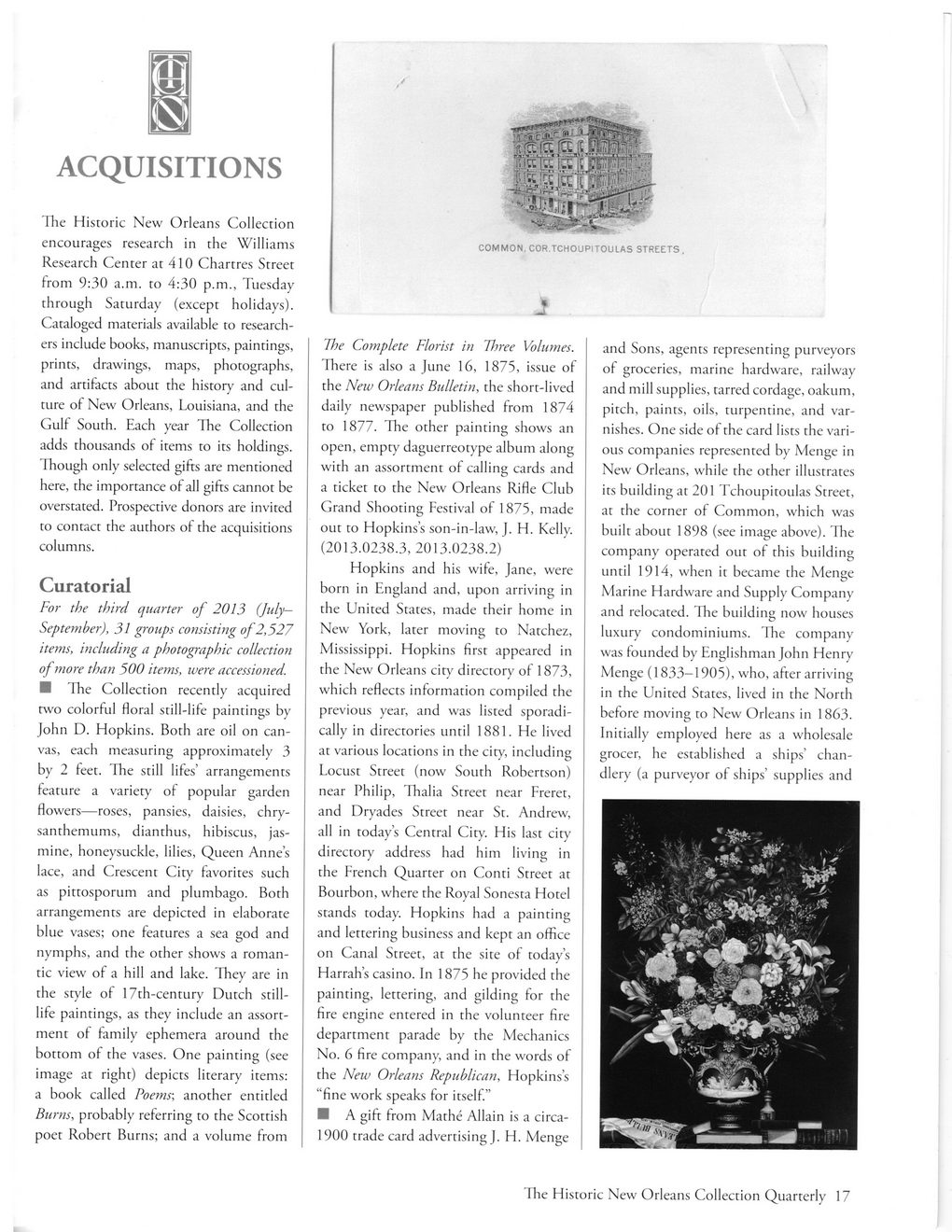This text was obtained via automated optical character recognition.
It has not been edited and may therefore contain several errors.
m IS ACQUISITIONS The Historic New Orleans Collection COMMON, COR.TCHOUPITOULAS STREETS, encourages research in the Williams Research Center at 410 Chartres Street from 9:30 a.m. to 4:30 p.m., Tuesday through Saturday (except holidays). Cataloged materials available to researchers include books, manuscripts, paintings, prints, drawings, maps, photographs, and artifacts about the history and culture of New Orleans, Louisiana, and the Gulf South. Each year The Collection adds thousands of items to its holdings. Though only selected gifts are mentioned here, the importance of all gifts cannot be overstated. Prospective donors are invited to contact the authors of the acquisitions columns. Curatorial For the third quarter of 2013 (July— September), 31 groups consisting of 2,527 items, including a photographic collection of more than 500 items, were accessioned. ■ The Collection recently acquired two colorful floral still-life paintings by John D. Hopkins. Both are oil on canvas, each measuring approximately 3 by 2 feet. The still lifes’ arrangements feature a variety of popular garden flowers—roses, pansies, daisies, chrysanthemums, dianthus, hibiscus, jasmine, honeysuckle, lilies, Queen Anne’s lace, and Crescent City favorites such as pittosporum and plumbago. Both arrangements are depicted in elaborate blue vases; one features a sea god and nymphs, and the other shows a romantic view of a hill and lake. They are in the style of 17th-century Dutch still-life paintings, as they include an assortment of family ephemera around the bottom of the vases. One painting (see image at right) depicts literary items: a book called Poems; another entitled Burns, probably referring to the Scottish poet Robert Burns; and a volume from « The Complete Florist in Three Volumes. There is also a June 16, 1875, issue of the New Orleans Bulletin, the short-lived daily newspaper published from 1874 to 1877. The other painting shows an open, empty daguerreotype album along with an assortment of calling cards and a ticket to the New Orleans Rifle Club Grand Shooting Festival of 1875, made out to Hopkins’s son-in-law, J. H. Kelly. (2013.0238.3, 2013.0238.2) Hopkins and his wife, Jane, were born in England and, upon arriving in the United States, made their home in New York, later moving to Natchez, Mississippi. Hopkins first appeared in the New Orleans city directory of 1873, which reflects information compiled the previous year, and was listed sporadically in directories until 1881. He lived at various locations in the city, including Locust Street (now South Robertson) near Philip, Thalia Street near Freret, and Dryades Street near St. Andrew, all in today’s Central City. His last city directory address had him living in the French Quarter on Conti Street at Bourbon, where the Royal Sonesta Hotel stands today. Hopkins had a painting and lettering business and kept an office on Canal Street, at the site of today’s Harrah’s casino. In 1875 he provided the painting, lettering, and gilding for the fire engine entered in the volunteer fire department parade by the Mechanics No. 6 fire company, and in the words of the New Orleans Republican, Hopkins’s “fine work speaks for itself.” I A gift from Mathe Allain is a circa-1900 trade card advertising J. H. Menge and Sons, agents representing purveyors of groceries, marine hardware, railway and mill supplies, tarred cordage, oakum, pitch, paints, oils, turpentine, and varnishes. One side of the card lists the various companies represented by Menge in New Orleans, while the other illustrates its building at 201 Tchoupitoulas Street, at the corner of Common, which was built about 1898 (see image above). The company operated out of this building until 1914, when it became the Menge Marine Hardware and Supply Company and relocated. The building now houses luxury condominiums. The company was founded by Englishman John Henry Menge (1833-1905), who, after arriving in the United States, lived in the North before moving to New Orleans in 1863. Initially employed here as a wholesale grocer, he established a ships’ chandlery (a purveyor of ships’ supplies and Ihe Historic New Orleans Collection Quarterly 17

New Orleans Quarterly 2014 Winter (17)